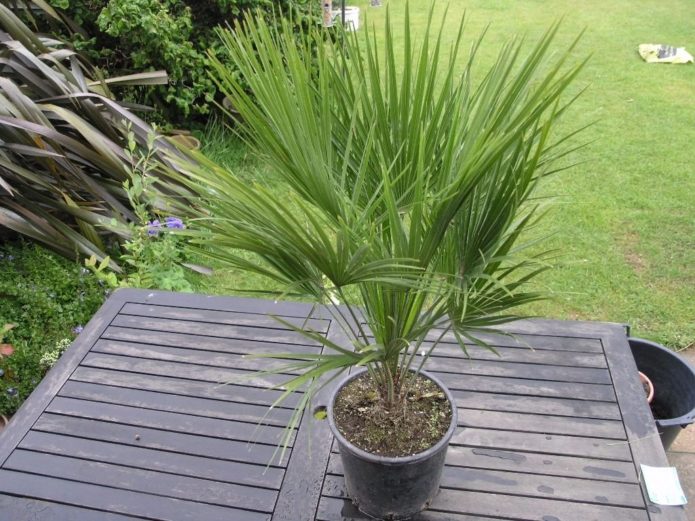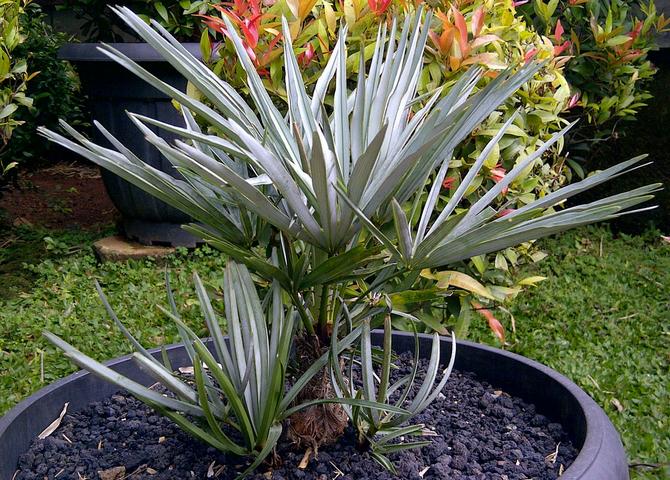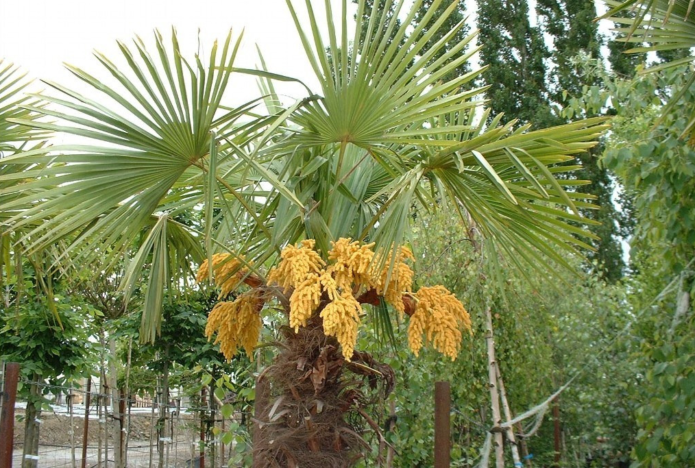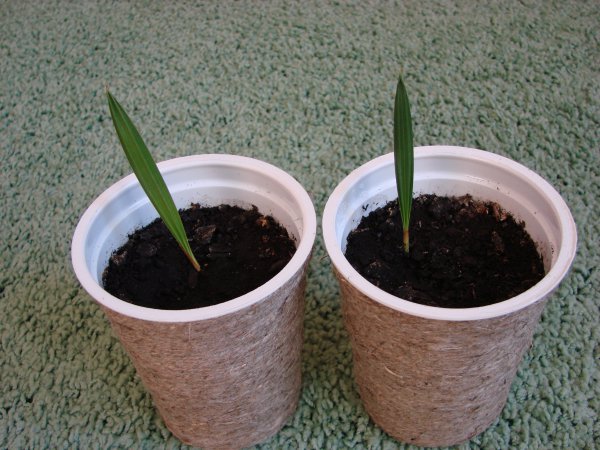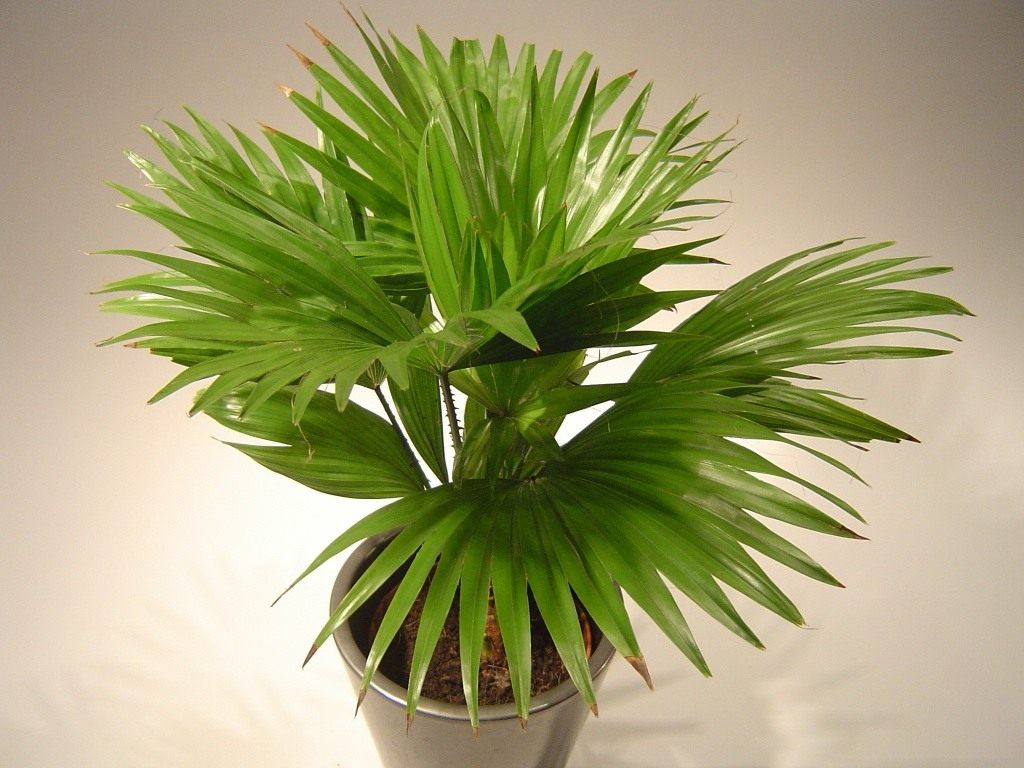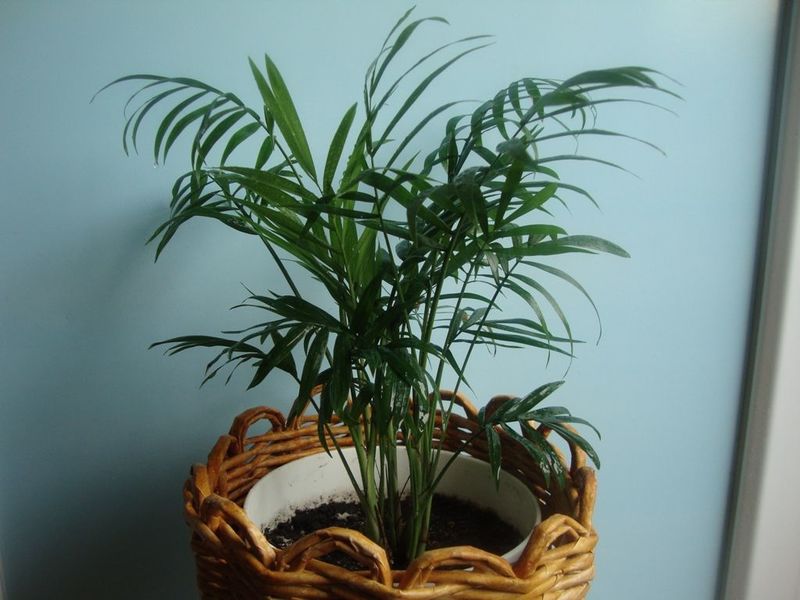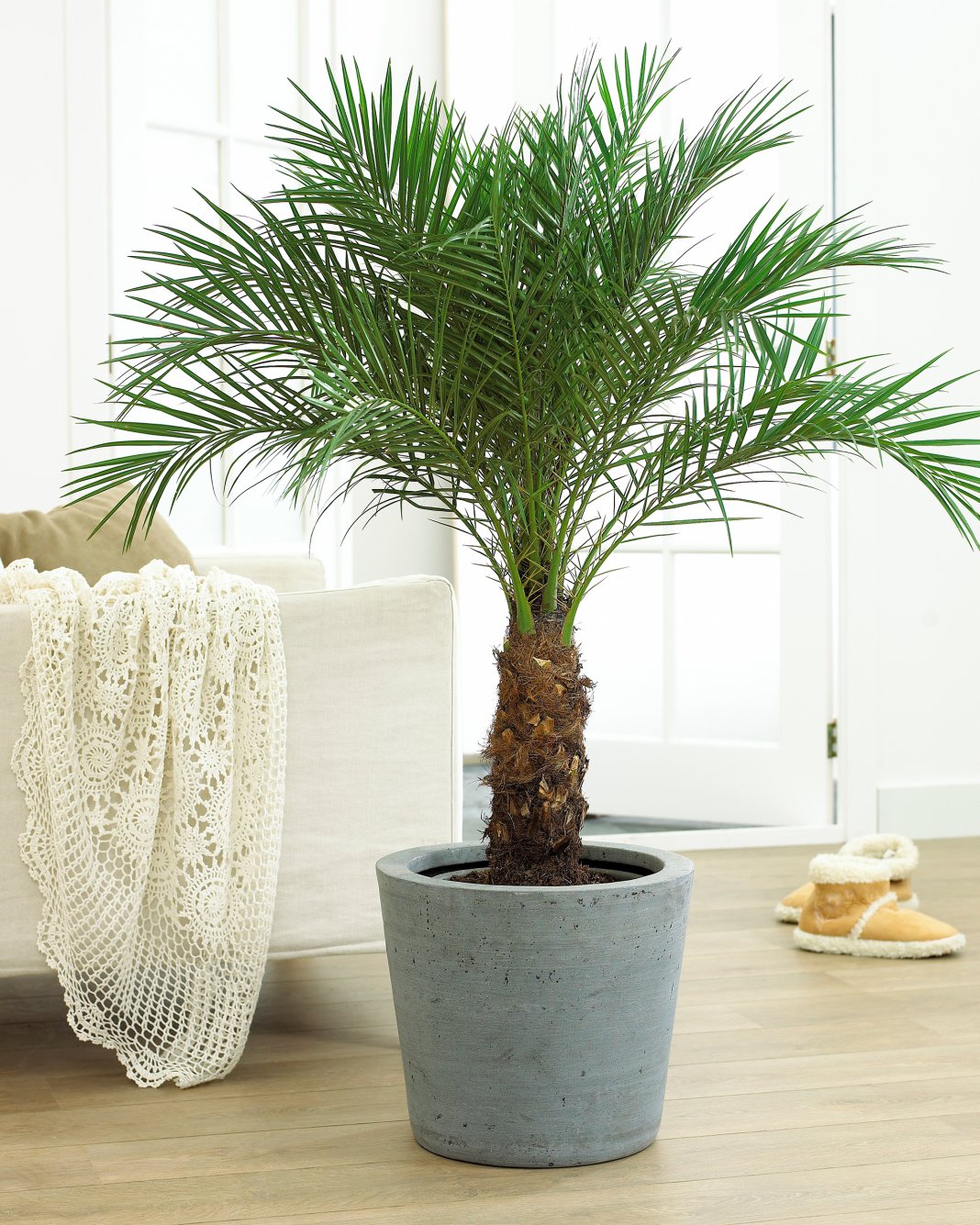Palm trees are a favorite of many plants that do not require serious care and take root well in difficult climates. Hamerops is the most popular in Europe. It is used as a decoration for parks and gardens, as well as an element of interior decoration. This plant can be easily grown at home if you know its features and conditions of detention.
Content
Description and characteristics
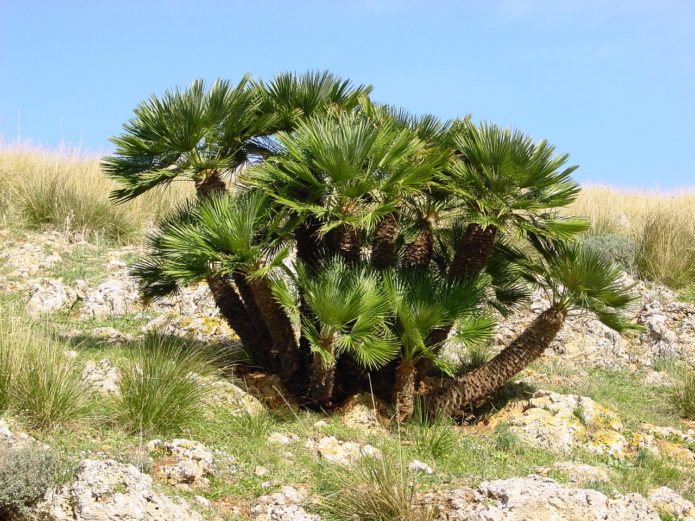
On the bases of the petioles of the palm there are small thorns that protect the trunk from being eaten by animals
Palm hamerops belongs to the Arekov family and is considered the only representative of it that is found on the European continent, as the rest prefer Africa. The main places of its growth are the southwestern part of the mainland, including Italy, Spain, Portugal, Malta, as well as some parts of the coast of France. In Russia, the culture can be found near the Black Sea, and in other places it is grown as a houseplant.
Hamerops is a bush with several trunks and one base with a diameter of 25-30 cm and a height of 3-5 meters. It is covered with brownish fibers. The crown consists of rounded, dissected leaves, due to which the plant is often called the fan palm.
The flowering period begins in March-June. Small inflorescences appear at the top of the stem and are bright yellow in color. After falling, fruits are formed in their place. They resemble red, orange or yellow berries.
Indoor views
At home, you can grow one type of plant - stocky. Outwardly, it practically does not differ from the culture that grows in the wild, but reaches a height of 1-1.5 meters. Palm trees are placed in spacious living quarters and offices, foyers and halls, as well as in winter gardens.
Growing conditions
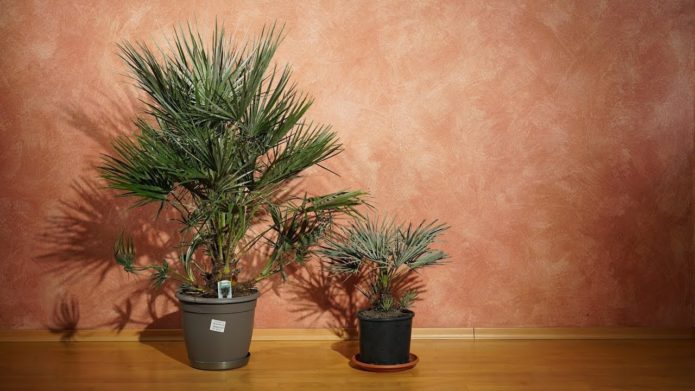
It is better to shade a young bush slightly from direct rays of the sun, otherwise burns will appear on the leaves
Under natural conditions, the palm tree grows in places with rocky soil and has a good survival rate. Therefore, keeping it at home is easy enough. The main thing to remember is that a palm tree needs a lot of space, since it has a rather lush cap of fan leaves. There are no special requirements for the quality of the substrate, but light soils with good drainage are preferred for the culture, in which moisture does not stagnate.
The room where the hamerops grows must be ventilated daily. In the summer, it is better to take a container with a palm tree outside - the plant loves fresh air.
Table: content rules
| Temperature | Summer temperatures should be 23–27 ° C, winter temperatures above 5–7 ° C. With a decrease in indicators below 5 ° C, the palm tree dies |
| Lighting | The plant thrives in a room with a fairly intense, diffused light and partial shade. It tolerates direct ultraviolet rays without problems, but in poor light it loses its leaf color and stops growing. |
| Humidity | The palm tree is insensitive to moisture conditions, but on hot days it should be sprayed from time to time with a spray bottle. In winter, irrigation should be stopped, and the leaves should be wiped from dust with a damp cloth. |
Planting and transplanting
Young trees are planted in a substrate consisting of clay and leafy soil, as well as sand, in a ratio of 2: 1: 1. It is necessary to add drainage to the soil, for which vermiculite or charcoal is suitable. Transplant process:
- They take a wide pot, put stones on the bottom, fill it with a substrate.
- Gently transfer the plant into a container along with an earthen clod. Cover with earth so that the root collar is at the surface level.
- They tamp the soil around the trunk a little, water the palm tree.
Transplantation of adult plants is performed every 4–5 years, in spring or summer after flowering ends.
In order for the palm tree to grow and develop well, the top layer of soil should be removed every year and filled with fresh mixture.
Does the palm need support
An adult plant does not need support, since it has a rather powerful trunk. Young palms may wobble a little immediately after transplanting. In this case, they should be secured with sticks, trellises or stretch marks. After the palm tree takes root and takes root well, the supports can be removed.
Care
The plant does not need special care - it comes down to watering and feeding, but they should be carried out regularly, otherwise the palm tree will lose its decorative appearance.
Process features:
- In spring and summer, the culture requires abundant moisture - it is best to navigate by the state of the substrate surface. As it dries, the plant should be watered with soft, settled water at room temperature, and also sprayed from a spray bottle.
- During the period of active growth (from spring to autumn), the palm tree is fed twice a month with complex fertilizers. In winter, it is sufficient to apply nutrient mixtures once a month.
Flowering period
Palm trees bloom in spring or summer, but it is difficult to attribute it to the benefits of culture. The inflorescences are so small and expressionless that they are usually simply not paid attention to. Special care is not required at this time, but if the owner wants to propagate the crop with seeds, they must be harvested after the fruits are ripe.
Winter care
At the end of autumn, the plant begins a dormant period - at this time it must be transferred to a cool (temperature 6–8 ° C) place with good lighting. Watering is reduced to a minimum, additional lighting or any additional care for the palm is not required. It is only necessary to occasionally wipe the dust from the leaves with a damp cloth. In the spring, the container with the plant is moved to its usual place, and as soon as the temperature outside the window is above 20 ° C, it can be put outside.
Shaping and pruning
It is strictly forbidden to prune a palm tree, since it has only one growth point, and its damage can lead to the death of the plant. Old leaves die off and fall off on their own - this is a normal process and should not be interfered with.
Possible problems
Problems with growing a palm are manifested with improper care - watering with cold water, high or low humidity or low temperatures. In this case, brown spots and creases appear on the leaves. If such signs occur, it is necessary to identify and eliminate care errors, otherwise the plant will die. Excessive watering is especially dangerous - if you constantly flood the roots, they will start to rot and it will be impossible to save the culture.
Diseases and pests
The plant is insensitive to diseases, but occasionally it can be affected by spider mites, thrips, whitefly and scale insects. Signs of pests are brown spots on the leaves and drying out, and in some cases insects can be seen with the naked eye.They can be dealt with with a solution of laundry soap, tobacco or garlic infusion. The compositions are gently wiped on the leaves several times a week. If simple methods of struggle do not work, you must use special insecticide preparations.
Reproduction
Hamerops are propagated in two ways - by layering and by seeds.
The first option is pretty simple:
- Take one of the processes that appear on the trunk of the palm tree (lateral layers are not suitable for these purposes).
- Rooted in a mixture of turf and leafy soil with perlite at a temperature of at least 25 ° C.
- Transplanted to a permanent place.
Seed propagation is a long and laborious process that does not always give the desired result. Planting process:
- Seeds are sorted out, defective and defective specimens are removed. Soak them in warm water for 5 days.
- Sod, compost, sand and humus are mixed in equal parts. Stones are laid on the bottom of the container, and the top is filled with a substrate.
- Seeds are sown at a shallow depth, covered with foil. Put away in a place with a temperature of at least 25 ° C.
- Seeds are sprayed from a spray bottle as the substrate dries up and fertilizing is added once a week.
Seedlings appear in 1–4 months, after which the film is removed, watering and fertilizing the seedlings is continued moderately.
As soon as the young plants grow slightly, they can be transplanted into separate containers.
Hamerops is an original houseplant that will decorate any interior, and with proper care it will delight the eye with bright green leaves for a long time.
